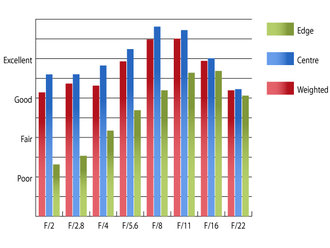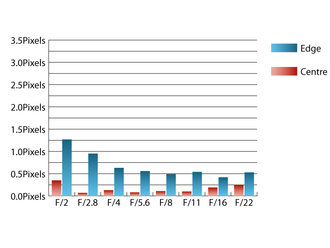Voigtlander 40mm f/2 Ultron SL II Review
Voigtlander 40mm f/2 Ultron SL II Performance
Sharpness is very good in the centre at maximum aperture, although performance towards the edges of the frame falls behind somewhat, producing fairly poor levels of clarity. Stopping down improves performance across the frame, although the clarity towards the edges of the frame never really reaches the high levels of sharpness produced in the centre of the frame. The best performance across the frame is achieved at f/11. Here sharpness is outstanding in the centre of the frame and very good towards the edges.
 MTF |
How to read our chartsThe blue column represents readings from the centre of the picture frame at the various apertures and the green is from the edges. Averaging them out gives the red weighted column.The scale on the left side is an indication of actual image resolution. The taller the column, the better the lens performance. Simple. For this review, the lens was tested on a Nikon D600 using Imatest. |
Chromatic aberrations are on the high side, especially at maximum aperture, where fringing towards the edges of the frame exceeds 1.25 pixel widths. This level of fringing may be noticeable in areas of high contrast towards the edges of the frame.
 CA |
How to read our chartsChromatic aberration is the lens' inability to focus on the sensor or film all colours of visible light at the same point. Severe chromatic aberration gives a noticeable fringing or a halo effect around sharp edges within the picture. It can be cured in software.Apochromatic lenses have special lens elements (aspheric, extra-low dispersion etc) to minimize the problem, hence they usually cost more. For this review, the lens was tested on a Nikon D600 using Imatest. |
Falloff of illumination towards the corners is very pronounced, with the corners being 2.55 stops darker than the centre of the frame at maximum aperture and illumination not visually uniform until the lens is stopped down to f/8 or beyond.
Imatest detected 1.68% barrel distortion, which is a fairly low level of distortion, which may be difficult to spot. If absolutely straight lines are paramount, you'll be glad to know that the distortion pattern is uniform across the frame, which should make applying corrections in image editing software straightforward.
Contrast is good, although it is reduced when shooting into the light at maximum aperture. The shallow hood goes some way towards shading the lens from extraneous light that may cause issues with flare, but it isn't very deep, and the opening could be narrower without shading the image area.
Value For Money
The Nikon version of this lens costs around £415 from RobertWhite, which seems reasonable, given that there are no direct equivalents currently available from either Canon, or Nikon and that the build quality of the lens is excellent.
Add your message
Login required
Please login here or if you've not registered, you can register here. Registering is safe, quick and free.
Please login here or if you've not registered, you can register here. Registering is safe, quick and free.
photodo Stats
1102 lenses
428 MTF tests
74 in-depth photodo reviews
100+ users join each day
Help the lens community by reviewing or rating a lens today via our lens search
428 MTF tests
74 in-depth photodo reviews
100+ users join each day
Help the lens community by reviewing or rating a lens today via our lens search
Latest Lens Reviews
- Chinon 28mm f/2.8 Vintage Lens Review
- Canon EF 70-200mm f/4L IS II USM Lens Review
- Samyang AF 85mm f/1.4 EF Review
- Sigma 70mm f/2.8 DG Macro Art Review
- Samyang AF 24mm f/2.8 FE Review
- Meike 50mm f/1.7 Review
- Tamron 70-210mm f/4 Di VC USD Review
- Lensbaby Burnside 35mm f/2.8 Review
- Asahi Super Takumar 50mm f/1.4 Review
- Asahi Super-Multi-Coated Takumar 135mm f/3.5 Review
